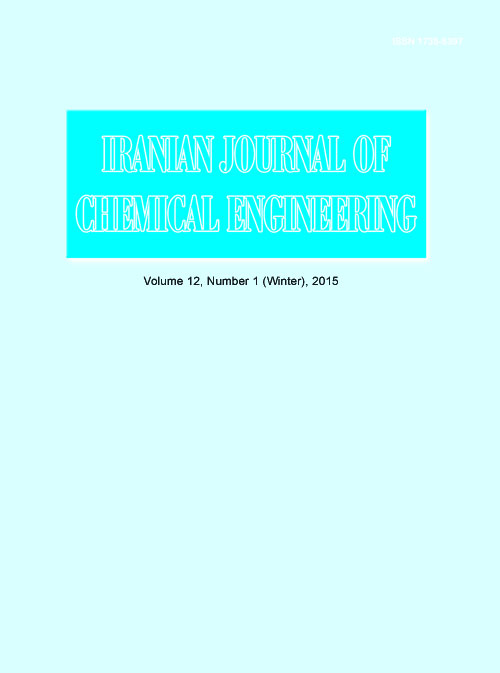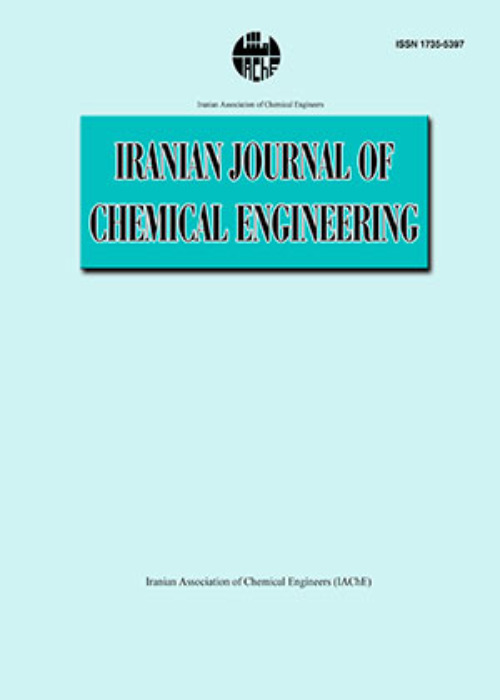فهرست مطالب

Iranian journal of chemical engineering
Volume:12 Issue: 1, Winter 2015
- تاریخ انتشار: 1394/06/21
- تعداد عناوین: 7
-
-
Page 3Sorption of contaminants in soil and sequestration in soil particles is a process, the mechanisms of which are not well understood as yet. The aim of this study was to investigate sequestration and bioavailability of crude oil as a contaminant in three different soils. For this purpose, three different soil samples with different textures (loamy sand, loam, and clay loam) but with the same organic carbon were collected. After sterilization, the soils were spiked with crude oil. Each soil sample was contaminated as aged and fresh, and inoculated with a consortium of three bacterial isolates. Respiration was analyzed on days 0, 30, 60, and 90 after inoculation. Bacterial population was also assessed at the beginning and at the end of the bioremediation and residual contaminant at the end of the bioremediation process. The results showed that in soils with the same organic carbon, texture is an important parameter in aging and sequestration of the contaminant. In addition, it was observed that the best degradation was accomplished in the loam soil, due to more bioavailability as compared to the clay loam soil and less inhibitory effect of the contaminant on microbial growth, resulting from lower bioavailability, as compared to the loamy sand soil.Keywords: Bioavailability, Bioremediation, Soil Texture, Crude Oil Contaminated Soil, Sequestration
-
Page 13Chabazite zeolite membranes were synthesized for their potential application in dehydration of natural gas. The membranes were prepared using secondary growth method on porous α-alumina substrates. Hydrothermal treatment was applied for the synthesis of chabazite seeds. The membranes were synthesized at four temperatures of 100, 120, 140, and 160°C; and duration of 20 h. Separation performance of as-synthesized membranes was evaluated through permeation of water vapor and methane as single gas. Moreover, the structure and morphology of as-synthesized chabazite zeolite membranes as well as seeds were characterized using scanning electron microscopy (SEM), X-ray diffraction (XRD), and dynamic light scattering (DLS). The results revealed that the optimum temperature for the synthesis of chabazite membranes is 140°C while at lower and higher temperatures, lower separation performances were observed. At the optimum synthesis temperature, an ideal selectivity of 23 was obtained for water vapor/methane, while a thin and integrated chabazite zeolite layer of about 5 m in thickness was synthesized over the surface of alumina substrate.Keywords: Zeolite Membrane, Chabazite, Natural Gas, Dehydration, Secondary Growth
-
Page 22There has been considerable interest in developing albumin nanoparticles as drug delivery devices. Albumin is an important endogenous antioxidant due to its potential of acting as reactive oxygen species scavenger. On the other hand, toxicity of silver nanoparticles had been demonstrated on cancer cell lines. In the present study, Ag NPs coated with BSA NPs were synthesized by silver nanoparticles which were coated with bovine serum albumin (BSA) via desolvation technique. The Ag NPs coated with BSA NPs formation was confirmed by UV-Vis spectroscopy and Dynamic Light Scattering (DLS). Human breast cancer cells (MCF7 cells) were then cultured in the presence of the nanoparticles to evaluate the cytotoxicity of Ag NPs coated with BSA NPs by the MTT colorimetric technique. The antioxidant activities of Ag NPs coated with BSA NPs were evaluated in terms of their inhibition of autoxidation rate of pyrogallol as superoxide. The effect of Ag NPs coated with BSA NPs on MCF7 exhibit a dose-dependent toxicity for the cell tested and the viability of MCF-7 decreased to 50% (LD50) at the concentration of 5 μg/mL. The IC50 value of antioxidant activities of Ag NPs coated with BSA NPs were 8 µg/mL which demonstrated that Ag NPs coated with BSA NPs were good superoxide scavengers. In conclusion, our data show that Ag NPs coated with BSA NPs had antioxidant and anticancer activities in MCF-7 cells.Keywords: Silver Nanoparticles, bovine serum Albumin, Breast Cancer cells, MCF, 7
-
Page 30In this paper, we report for the first time, thermal conductivity behavior of nanofluids containing decorated MWCNTs with different amount of TiO2 nanoparticles. TEM image confirmed that the outer surface of MWCNTs successfully decorated with TiO2 nanoparticles. The results of thermal conductivity behavior of nanofluids revealed that the thermal conductivity and enhancement ratio of thermal conductivity of MWCNTs-TiO2 at different amount of TiO2 nanoparticles are higher than those of TiO2 and MWCNTs nanofluids. Temperature and weight fraction dependence study also shows that the thermal conductivity of all nanofluids increases with temperature and weight fraction. However, the influence of temperature is more significant than that of weight fraction. We also found that decreasing amount of TiO2 nanoparticles which introduce the outer surface of MWCNTs leads to the augmentation of thermal conductivity of nanofluids containing MWCNTs-TiO2.Keywords: MWCNT, TiO2 Nanoparticles, Decoration, Thermal Conductivity
-
Page 42The hydrodynamic characteristics of dense conical fluidized bed were investigated experimentally and numerically. Experimental studies have been carried out in a bed containing TiO2 particles belonging to A/C boundary of Geldart''s classification with a wide particle size distribution. Pressure measurements and an optical fiber technique allowed determining the effect of high bed particles loading on the minimum fluidization velocity، local solid volume fraction and solid velocity. Two-fluid model approach with three different drag models and boundary conditions (BCs) consisting of no-slip، partial-slip and free-slip BC is presented for the numerical predictions. In this paper، we show the Gidaspow drag function with k-ε turbulent model by applying the partial-slip BC can improve the numerical results at high particle loading.Keywords: Dense flow, Micrometric Particles, Conical Fluidized Bed, Particles Loadings, Numerical Approach
-
Page 60The distillation process remains as the most common method of separation in chemical process industries. The energy used from this process accounts for an estimated 3% of the world energy consumption. The Dividing-Wall Column (DWC) for separation of multi-component mixtures has recently become a major concern of industries. The design of DWC is based on Thermally Coupled Distillation System (TCDS) eliminating some of the operational equipment. This paper presents the results of simulation of a DWC by using 3-simple sequence column model based on shortcut method by a commercial chemical Engineering software for purification of 1,3 butadiene unit.From the results, it is shown, by using a DWC instead of two conventional sequential column, the heat duties of both the condenser and the reboiler are reduced about 28.5% and also desirable purity of the key-components for the case of study have been achieved.Keywords: Distillation, Dividing Wall Column, Modeling, Simulation, Thermally Coupled
-
Page 68In this paper, the experimental investigation of solubility and initial absorption rate of CO2 gas in methanol and 1-ethyl-3-methylimidazolium ethylsulfate, [emim][EtSO4] solution of amine-functionalized imidazolium based ionic liquids, namely 1-(3-aminopropyl)-3-methylimidazolium, [apmim], with tetrafluoroborate, [BF4], hexafluorophosphate, [PF6] and trifluoromethanesulfonate [OTf] anions are presented. All ionic liquids in this work are synthesized according to literature procedure and all experimental trials were carried out at T=303.15 K and pressure from atmospheric to 40 bar.Keywords: Task Specific Ionic Liquids, Solubility, Initial Rate of Absorption, Physical Solvent


